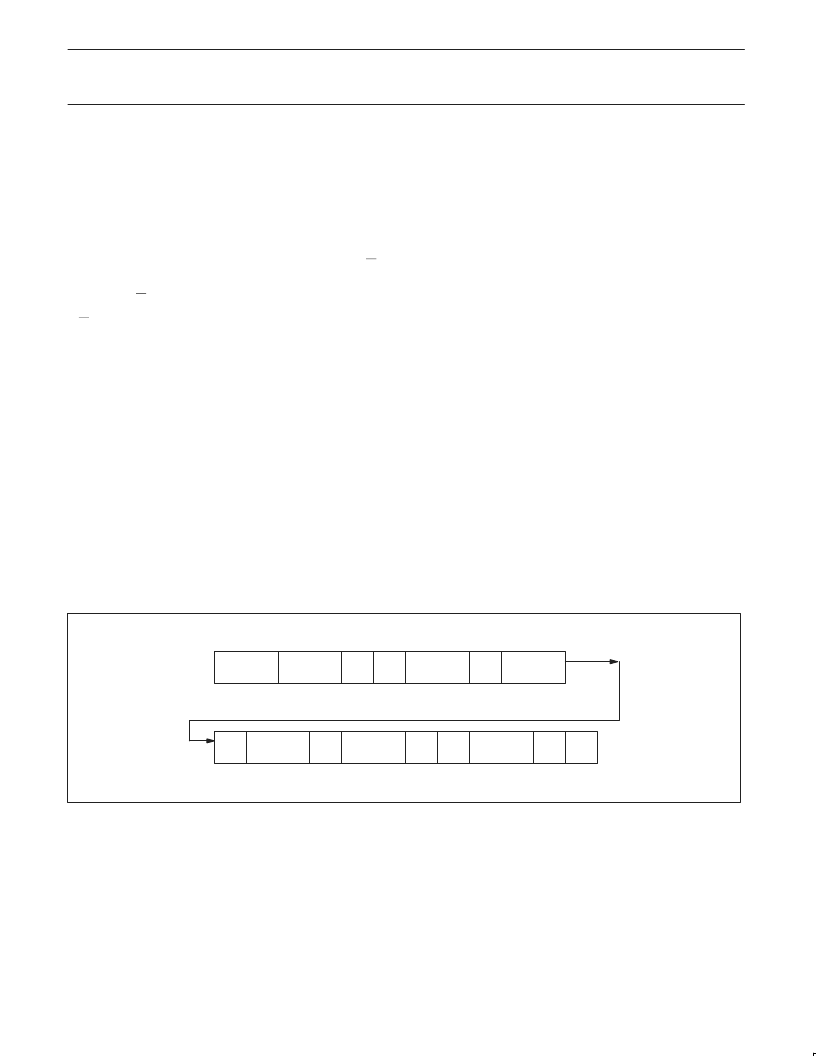- 您現(xiàn)在的位置:買賣IC網(wǎng) > PDF目錄369950 > PCK2002MPW (NXP SEMICONDUCTORS) 0-300 MHz I2C 1:10 clock buffer PDF資料下載
參數(shù)資料
| 型號: | PCK2002MPW |
| 廠商: | NXP SEMICONDUCTORS |
| 元件分類: | 時(shí)鐘及定時(shí) |
| 英文描述: | 0-300 MHz I2C 1:10 clock buffer |
| 中文描述: | PCK2000 SERIES, LOW SKEW CLOCK DRIVER, 10 TRUE OUTPUT(S), 0 INVERTED OUTPUT(S), PDSO28 |
| 封裝: | 4.40 MM, PLASTIC, MO-153, SOT361-1, TSOP-28 |
| 文件頁數(shù): | 6/12頁 |
| 文件大?。?/td> | 92K |
| 代理商: | PCK2002MPW |

Philips Semiconductors
Product data
PCK2002M
0–300 MHz I
2
C 1:10 clock buffer
2001 Jul 19
6
I
2
C CONSIDERATIONS
I
2
C has been chosen as the serial bus interface to control the PCK2001M. I
2
C was chosen to support the JEDEC proposal JC-42.5 168-Pin
Unbuffered SDRAM DIMM. All vendors are required to determine the legal issues associated with the manufacture of I
2
C devices.
1) Address assignment: The clock driver in this specification uses the single, 7-bit address shown below. All devices can use the address if only
one master clock driver is used in a design. The address can be re-used for the CKBF device if no other conflicting I
2
C clock driver is used in
the system.
The following address was confirmed by Philips on 09/04/96.
A6
A5
A4
A3
A2
A1
A0
R/W
1
1
0
1
0
0
1
0
NOTE:
The R/W bit is used by the I
2
C controller as a data direction bit. A ‘zero’ indicates a transmission (WRITE) to the clock device. A ‘one’
indicates a request for data (READ) from the clock driver. Since the definition of the clock buffer only allows the controller to WRITE data; the
R/W bit of the address will always be seen as ‘zero’. Optimal address decoding of this bit is left to the vendor.
2) Options: It is our understanding that metal mask options and other pinouts of this type of clock driver will be allowed to use the same address
as the original CKBF device. I
2
C addresses are defined in terms of function (master clock driver) rather than form (pinout, and option).
3) Slave/Receiver: The clock driver is assumed to require only slave/receiver functionality. Slave/transmitter functionality is optional.
4) Data Transfer Rate: 100 kbits/s (standard mode) is the base functionality required. Fast mode (400 kbits/s) functionality is optional.
5) Logic Levels: I
2
C logic levels are based on a percentage of V
DD
for the controller and other devices on the bus. Assume all devices are
based on a 3.3 Volt supply.
6) Data Byte Format: Byte format is 8 Bits as described in the following appendices.
7) Data Protocol: To simplify the clock I
2
C interface, the clock driver serial protocol was specified to use only block writes from the controller.
The bytes must be accessed in sequential order from lowest to highest byte with the ability to stop after any complete byte has been
transferred. Indexed bytes are not allowed. However, the SMBus controller has a more specific format than the generic I
2
C protocol.
The clock driver must meet this protocol which is more rigorous than previously stated I
2
C protocol. Treat the description from the viewpoint of
controller. The controller “writes” to the clock driver and if possible would ‘‘read” from the clock driver (the clock driver is a slave/receiver only
and is incapable of this transaction.)
“The block write begins with a slave address and a write condition. After the command code the host (controller) issues a byte count which
describes how many more bytes will follow in the message. If the host had 20 bytes to send, the first byte would be the number 20 (14h),
followed by the 20 bytes of data. The byte count may not be 0. A block write command is allowed to transfer a maximum of 32 data bytes.”
SW00279
1 bit
7 bits
1
1
8 bits
1
Start bit
Slave Address
R/W
Command Code
Byte Count = N
Ack
Data Byte 1
Ack
Data Byte 2
Ack
...
Data Byte 2
Ack
Stop
Ack
Ack
1 bit
8 bits
1
1
8 bits
1
8 bits
1
NOTE:
The acknowledgement bit is returned by the slave/receiver (the clock driver).
Consider the command code and the byte count bytes required as the first two bytes of any transfer. The command code is software
programmable via the controller, but will be specified as 0000 0000 in the clock specification. The byte count byte is the number of additional
bytes required to transfer, not counting the command code and byte count bytes. Additionally, the byte count byte is required to be a minimum of
1 byte and a maximum of 32 bytes to satisfy the above requirement.
相關(guān)PDF資料 |
PDF描述 |
|---|---|
| PCK2002P | 140 MHz PCI-X clock buffer |
| PCK2002PDP | 140 MHz PCI-X clock buffer |
| PCK2002PD | 140 MHz PCI-X clock buffer |
| PCK2002 | 0-300 MHz I2C 1:18 clock buffer |
| PCK2002DGG | 0-300 MHz I2C 1:18 clock buffer |
相關(guān)代理商/技術(shù)參數(shù) |
參數(shù)描述 |
|---|---|
| PCK2002MPW,112 | 功能描述:時(shí)鐘緩沖器 14.318-167MHZ I2C 1:10CLK BUFR RoHS:否 制造商:Texas Instruments 輸出端數(shù)量:5 最大輸入頻率:40 MHz 傳播延遲(最大值): 電源電壓-最大:3.45 V 電源電壓-最小:2.375 V 最大功率耗散: 最大工作溫度:+ 85 C 最小工作溫度:- 40 C 封裝 / 箱體:LLP-24 封裝:Reel |
| PCK2002MPW,118 | 功能描述:時(shí)鐘緩沖器 14.318-167MHZ I2C 1:10CLK BUFR RoHS:否 制造商:Texas Instruments 輸出端數(shù)量:5 最大輸入頻率:40 MHz 傳播延遲(最大值): 電源電壓-最大:3.45 V 電源電壓-最小:2.375 V 最大功率耗散: 最大工作溫度:+ 85 C 最小工作溫度:- 40 C 封裝 / 箱體:LLP-24 封裝:Reel |
| PCK2002MPW-T | 功能描述:時(shí)鐘緩沖器 14.318-167MHZ I2C 1:10CLK BUFR RoHS:否 制造商:Texas Instruments 輸出端數(shù)量:5 最大輸入頻率:40 MHz 傳播延遲(最大值): 電源電壓-最大:3.45 V 電源電壓-最小:2.375 V 最大功率耗散: 最大工作溫度:+ 85 C 最小工作溫度:- 40 C 封裝 / 箱體:LLP-24 封裝:Reel |
| PCK2002P | 制造商:PHILIPS 制造商全稱:NXP Semiconductors 功能描述:140 MHz PCI-X clock buffer |
| PCK2002PD | 功能描述:時(shí)鐘緩沖器 14.318-140MHZ PCI-X CLOCK BUFR RoHS:否 制造商:Texas Instruments 輸出端數(shù)量:5 最大輸入頻率:40 MHz 傳播延遲(最大值): 電源電壓-最大:3.45 V 電源電壓-最小:2.375 V 最大功率耗散: 最大工作溫度:+ 85 C 最小工作溫度:- 40 C 封裝 / 箱體:LLP-24 封裝:Reel |
發(fā)布緊急采購,3分鐘左右您將得到回復(fù)。